Best budget e-MTBs 2024 – top-rated cheap electric mountain bikes that won't break the bank
Go further and faster for less with our pick of the most affordable e-MTBs
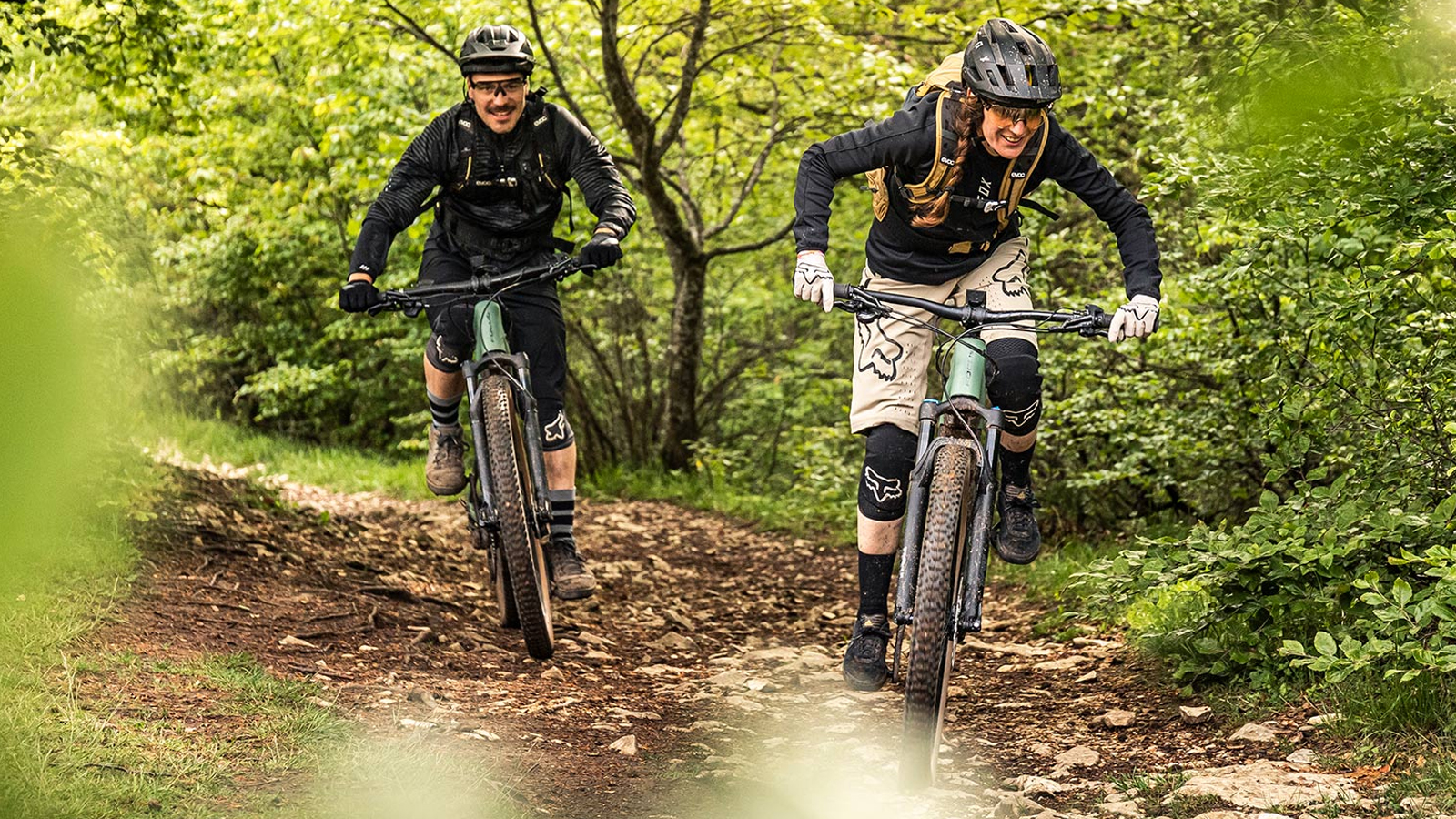
The best budget e-MTBs can help you power up troublesome hills without costing an arm and a leg.
Motors and batteries have improved massively over the last decade, meaning that electric mountain bikes are now more reliable, more powerful, and have bigger riding ranges than ever before.
With these advances in e-bike technology and performance, e-MTBs have become much more affordable. There are lots of worthy options out there, so you're bound to find something that suits you.
If you're on a budget, you may well also be considering the best electric hardtails. But while they are fine for riding tracks, towpaths and blue trail runs, being heavy and lacking rear suspension, they're not really up to proper mountain biking so that's why all the bikes recommended here are full-suspension models.
We've picked the best budget e-MTBs available right now. For more info on how to buy an e-MTB, see our guide at the bottom of this page.
The best budget e-MTBs
Why trust BikePerfect
1. Best overall

Canyon Neuron:ON CF 7
Specifications
Reasons to buy
Reasons to avoid
Canyon's Neuron:ON 7 is a trail-oriented e-MTB that, similarly to its non-motorized counterpart, is pitched as an adventure-ready full-sus bike that can take you anywhere from a day at the local bike park to a week of singletrack exploration.
With its tamer geometry and stable handling, the Neuron:ON 7 is surefooted and feels planted in the trail. It positions the rider to sit 'in' the bike rather than on top, providing a confidence-inspiring and good-natured ride that prompts you to continue pedaling and push your limits.
It's equipped with a Shimano EP801 motor which offers 85Nm of torque and puts it on par with the Bosch Performance Line CX motor. The Neuron:ON 7 also comes armed with a 150mm dropper post (125mm for size XS and S).
Canyon has long concerned itself with creating a consistent ride feel across its range of sizes, varying its builds slightly for its small and extra-small frames. Shorter riders (on sizes XS and S) will benefit from smaller 27.5in wheels and 165mm cranks, though fork travel is reduced to 125mm as a result.
Canyon has also recently released the lighter-weight Neuron:ONfly.
2. Best entry level budget e-MTB
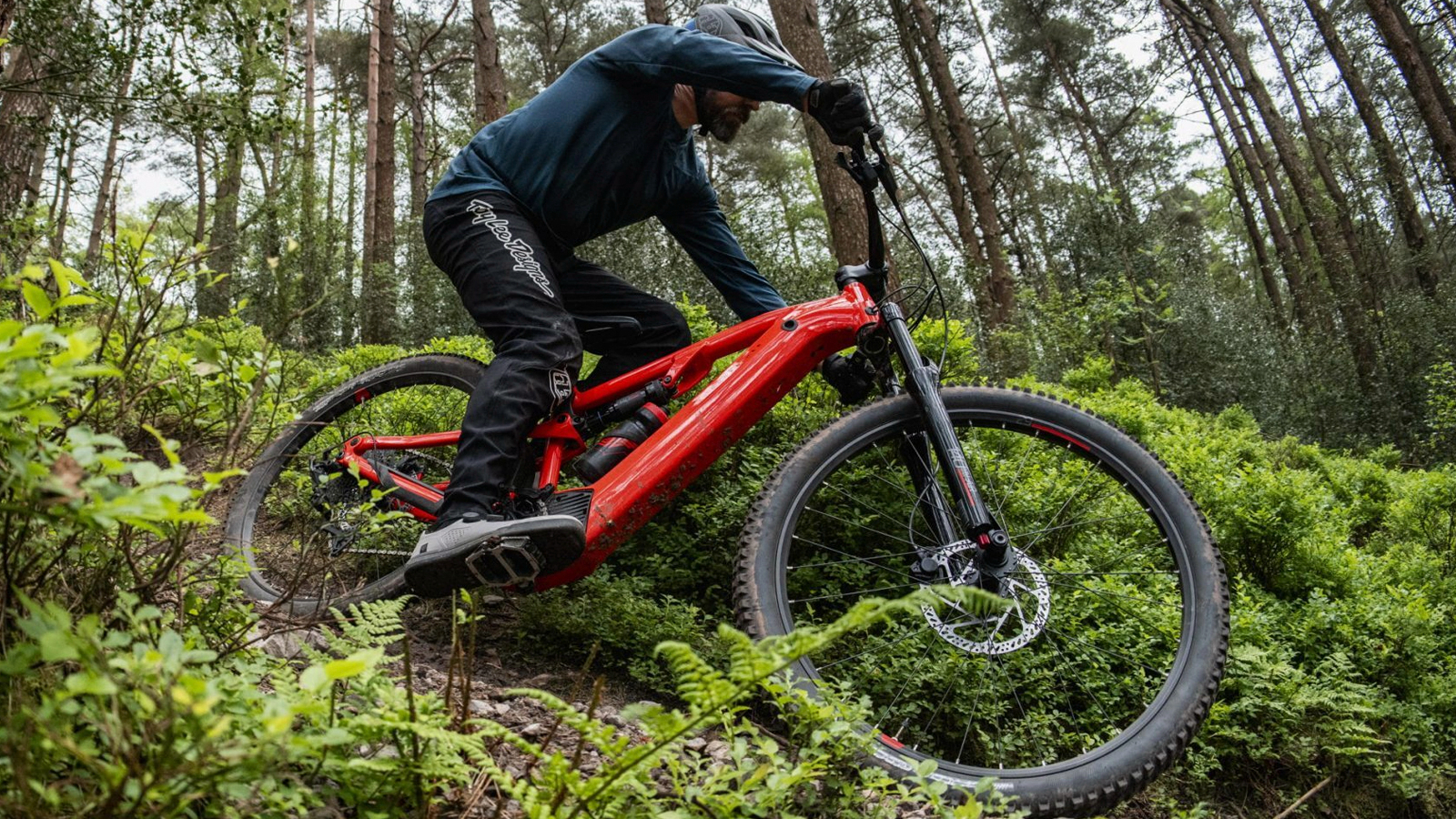
Decathlon Rockrider E-Expl 520 S
Specifications
Reasons to buy
Reasons to avoid
Decathlon's Rockrider brand is known for making bikes that usually outperform their bargain price tags, so it's no big surprise that it has delivered a superb bangs-per-buck electric MTB with the E-Expl 520 S.
The bike uses a 70Nm Brose T mid-power motor combined with a 500Wh battery that gives plenty of range. As well as its own branded motors, Brose also makes them for SRAM and Specialized e-MTBs, so has plenty of experience. 140mm suspension comes from X-Fusion, which is pretty basic but has tune-able air springs front and rear, plus a rebound adjuster on the fork so you can get the setup that suits you best. The frame geometry is on the money for a modern trail e-MTB too.
While we've yet to put this e-bike to the test, our colleagues over on MBR have already done so, with bike test editor, Alan Muldoon, scoring it 8/10 saying: "In creating the Rockrider E-EXPL 520S, Decathlon has forced everyone to rethink what’s possible from an entry-level, full-suspension e-bike. Sure, the sub £3k price point dictates that there are going to be some compromises in the specification, possibly with the durability of some of the component parts too, especially if you ride really hard. But that didn’t detract from the Rockrider's impressive ride quality. And what stood out most about the E-EXPL 520S was the smooth, near-silent motor, the balanced handling and the ability to push the Rockrider into terrain and situations it was never designed for."
The only real negative to the bike was that Alan found it took a full eight hours to recharge the battery.
For more, see MBR's Decathlon Rockrider E-Expl 520 S review.
2. Best for singletrack
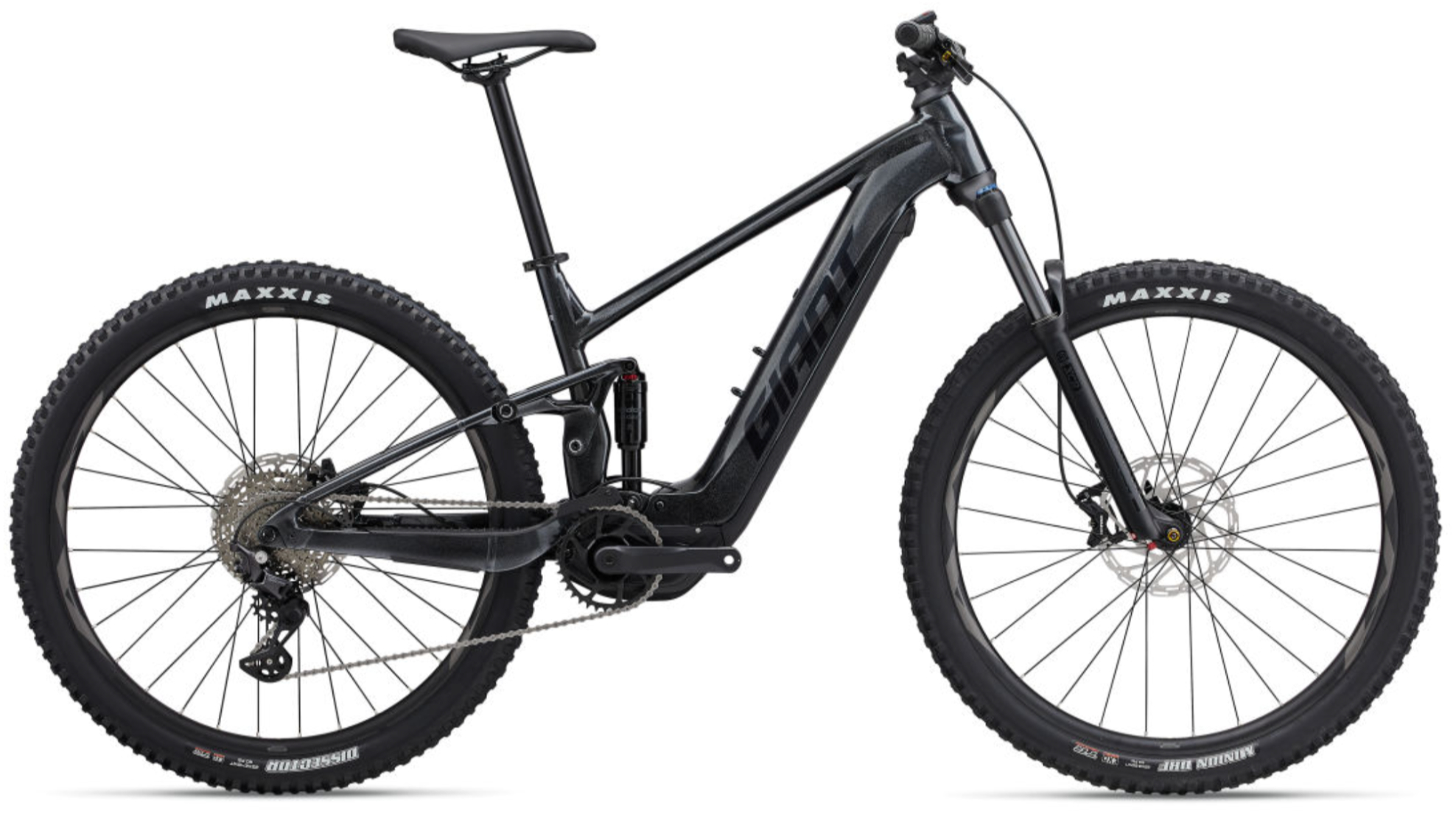
Giant Stance E+ 2 625
Specifications
Reasons to buy
Reasons to avoid
Giant has pulled out all the stops for the latest version of its entry-level full-suspension budget e-MTB, and it’s a really good-looking bike with some neat features.
The internal battery is a decent size and comes in the form of a 625Wh Giant EnergyPak cell – which can be removed for recharging if necessary. Giant also uses its own SyncDrive Sport motor with 70Nm of torque. That’s less than Bosch and Brose but is on par with other budget brands. The RideControl Plus display and phone app give tuneable support options, and Giant has an impeccable reputation for super-reliable components.
The alloy frame uses a rocker-driven Suntour Raiden shock with a flex-stay system, giving a ride-smoothing, if not boulder-eating 125mm of travel. The Suntour fork delivers a 140mm stroke through stiff 34mm legs, and you get Boost width bolt-through axles front and rear, plus a SRAM UDH mech hanger.
29er wheels help with rough play, and you get a top tire combo of a 2.5in Maxxis Minion DHF up front with a 2.4 Dissector at the rear. The tire carcasses are EXO versions, but ideally we'd like to see the tougher EXO+ versions instead. Shimano Deore is an older 10-speed drivetrain so there are no super low winch gears, but you do get an MRP chain guide. Tektro Orion brakes with 203mm rotors give reasonable power, although the feel is a bit wooden.
The frame geometry is decent enough without being cutting edge, but you’ll need to add a dropper post for descending confidence.
3. Best for rowdy riding

Haibike ALLMtn 1
Specifications
Reasons to buy
Reasons to avoid
While there are some cheaper options in Haibike's e-MTB lineup, we think it’s worth digging a bit deeper into your wallet to get the 160mm travel ALLMtn 1.
That gets you a distinctive angular alloy frame built around a Yamaha motor. Max torque is behind top-end Shimano, Bosch and Brose at only 70Nm, but that’s competitive with Shimano E7000. It also means tons of range and run time from the full-size internal battery. The steel-legged RockShox 35 Silver is certainly working hard at 160mm, but it’s tough enough to cope, and the Suntour shock is supple but not the best option.
A 38T front chainring means gearing is relatively high even with an 11-51T cassette at the back, but the Shimano Deore shift kit is super durable, and the Tektro Orion 4 piston brakes get 203mm rotors for extra power. Heavy-duty Rodi 35mm wide rims are wrapped in Continental Trail King tires for decent grip on the mullet wheeled setup (29-inch front wheel with a 27.5 rear). Haibike’s own wide bar, short stem and dropper post take control of a decent 65-degree head angle and 460mm reach on a large frame.
4. Best for cross-country
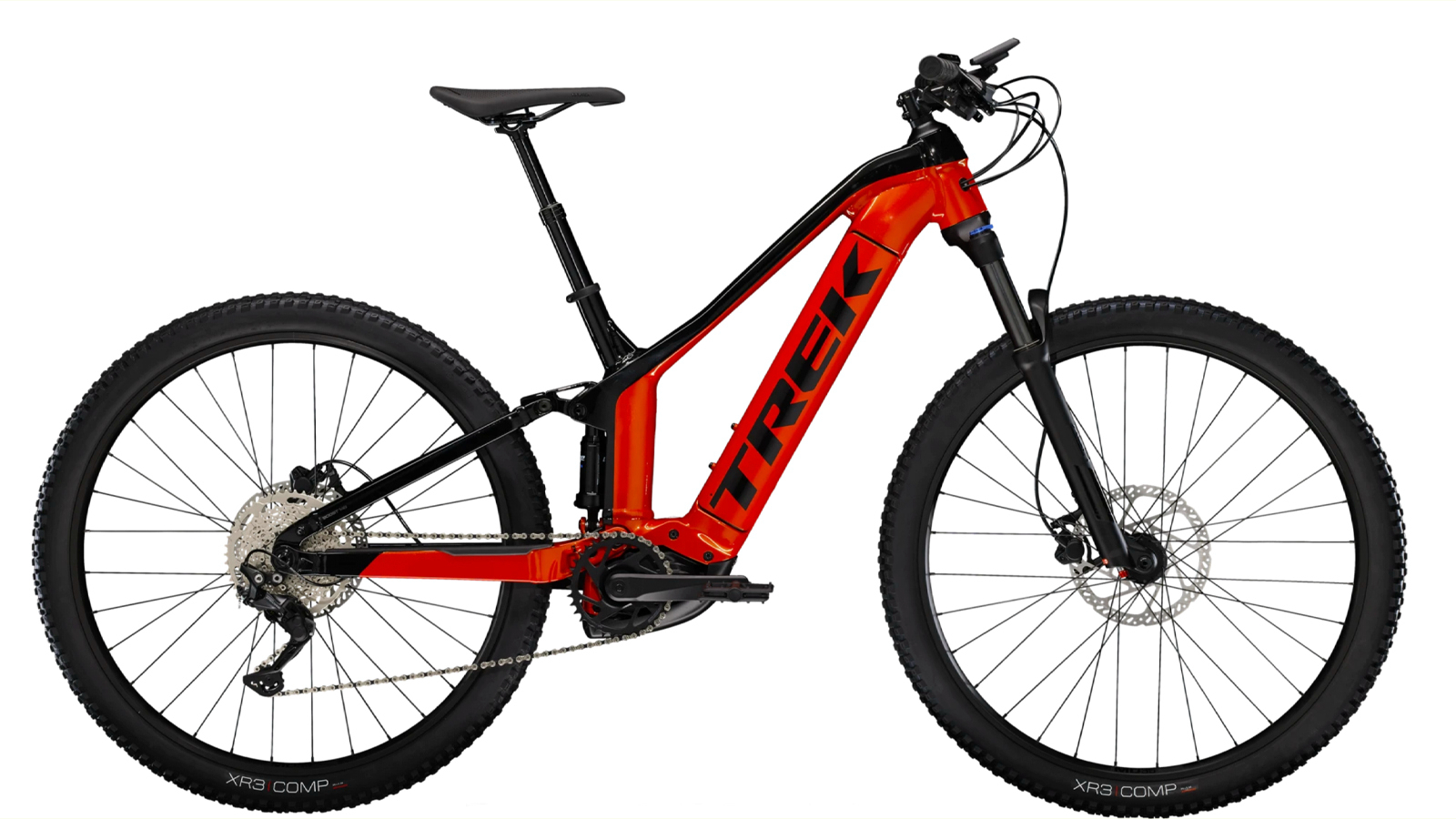
Trek Powerfly FS 4
Specifications
Reasons to buy
Reasons to avoid
While most of the best budget e-MTBs here are in the trail/enduro category, Trek is doing something deliberately different with its Powerfly FS XC e-MTBs which now come in the latest Gen 3 version.
By keeping rear travel to just 100mm and squeezing the rear shock behind the seat post it creates a really sleek-looking back end. It also leaves bottle cage room inside the mainframe, even with the big side loading RIB internal battery down tube. A super sloped top tube and extended seat tube with a dropper post give the front end a slightly ‘seahorse’ aesthetic. Geometry is a balanced XC mix of 66.5-degree head angle, 76-degree effective seat angle and 460mm reach on the large. 29er wheels on M-XL sizes are fast and easy rolling, while the XS and S sizes get 27.5-inch wheels for proportional agility. On either end, the Bontrager XR3 tires are fast but smooth over intermediate trails.
Getting up to speed and blasting the climbs is definitely no problem thanks to the full-power Bosch Performance CX Gen 4 motor, and you now get more range with 625Wh battery.
The Powerfly is a great speed-hungry e-bike, but it does come with a stiff but numb Suntour fork, slightly limited 10-speed Shimano Deore gear range and limp Tektro brakes, which means it's best suited to less technical, rolling trails.
5. Best female-specific
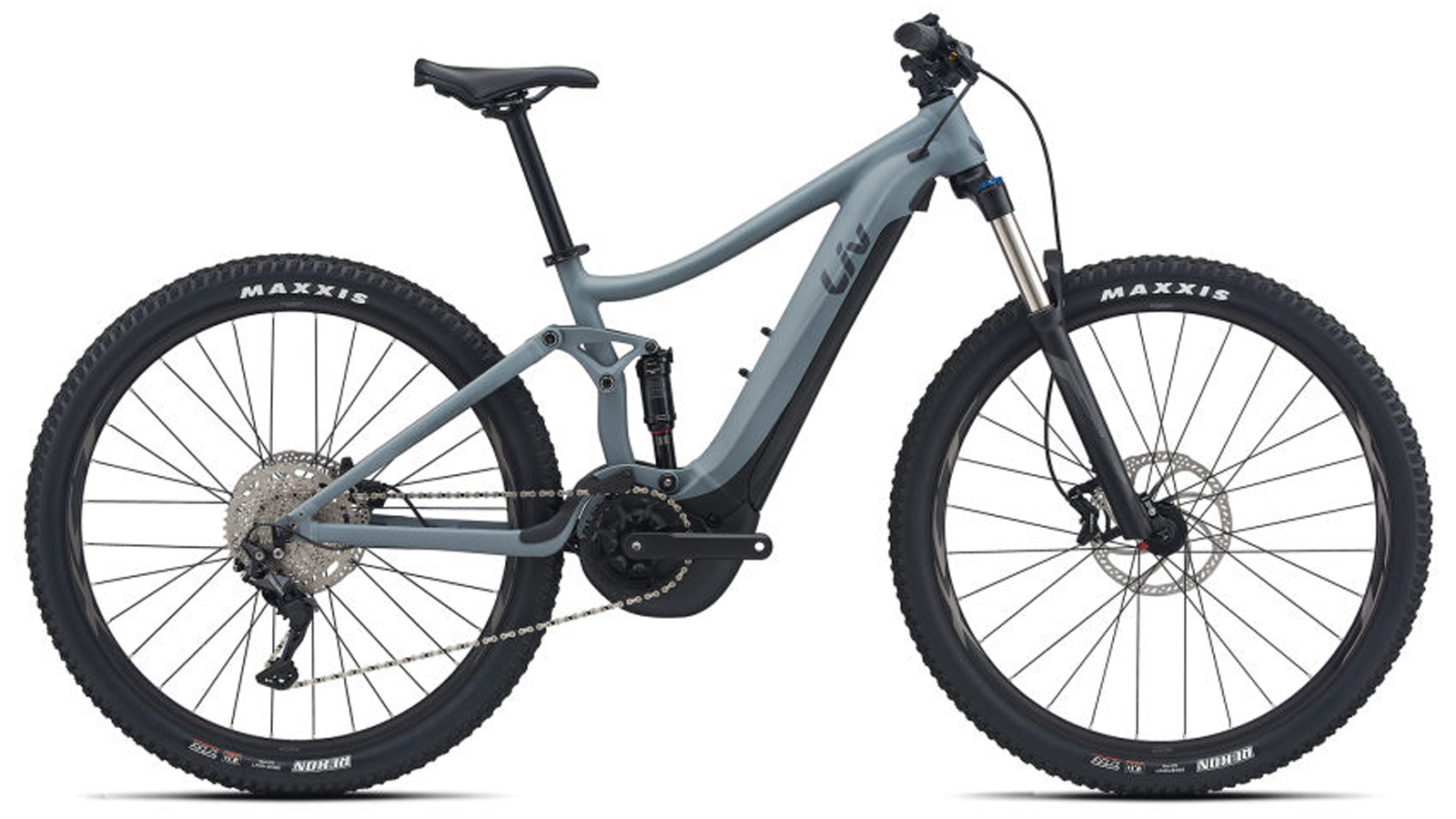
Liv Embolden E+ 2
Specifications
Reasons to buy
Reasons to avoid
As its name suggests, the Liv Embolden E+ 2 is designed to encourage new riders into the sport, and it's built to build confidence as it takes on the trails. Powered by the Yamaha SyncDrive Sport motor, the Embolden E+ 2 provides 70Nm of torque, which is estimated to supply 350 percent of the rider's effort through its Pedal Plus technology. In a nutshell, the motor uses sensors to assess pedal input from the rider, and responds with the appropriate assistance level to the mode that it's in use.
One of the key selling points for the Liv Embolden E+ 2 is that it is designed by, with and for women. Unlike other women's mountain bikes that are effectively a 'pink and shrink' version of the unisex model, Liv is a brand that specializes in building women's bikes from the ground up, using only female body dimensions data to fine-tune the fit for most women.
The Embolden E+ 2 is specced with 120mm of Flex Point suspension, provided by a linkage-driven single pivot system and RockShox Monarch RT shock at the rear. Upfront the SR Suntour XCR 34 fork delivers 130mm of travel and has room enough for Maxxis Rekon 2.4in tubeless tires.
6. Best component choice
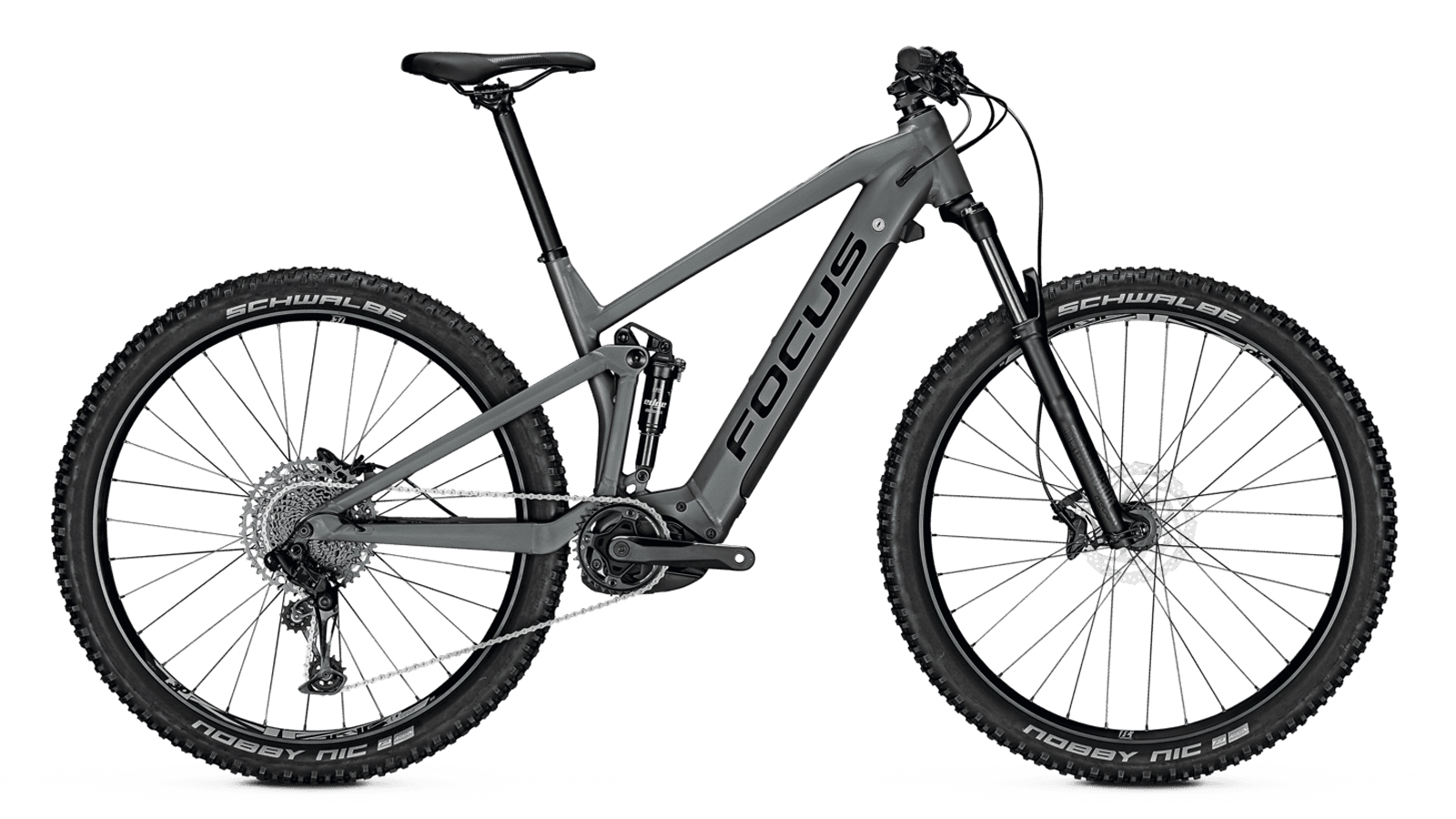
Focus Thron2 6.7
Specifications
Reasons to buy
Reasons to avoid
Thron2 is the shortest travel and most affordable range from Focus, but you’re still getting really neatly designed, quick 29er trail bikes based around a full 85Nm power Bosch Performance CX Gen 4 motor. A 625Wh battery gives a decent amount of range, while Maxxis Minion DNF tires front and rear give tons of assured grip.
The RockShox Recon RL forks aren’t over-stressed at 130mm of travel, and the Focus FOLD rocker suspension combines well with the RockShox Super Deluxe rear shock.
Angles are okay for a shorter travel trail bike, but reach is on the short side at 450mm on the large so it’s more playful than capable in ride character. That means it’s more agile on the flats and climbs, and the 760mm bars and 60mm stem is sized to suit that, too. An 11-speed Shimano Cues drivetrain and the powerful Bosch CX motor make short work on technical climbs, and the four-piston Shimano brakes are pretty much flawless. The very solid component package is completed with a dropper post.
7. Best carbon framed bike

Cube Stereo Hybrid 140 HPC Race 625
Specifications
Reasons to buy
Reasons to avoid
Cube does have 120- and 160mm e-bikes in its Stereo Hybrid range, but for all-round usability and agility the 140mm bikes sit bang in the middle.
Incredibly, the entry-level Race 625 still gets the HPC High Performance Composite carbon front end to keep weight under 25kg, even with a full-size 625Wh Powertube battery. You also get a full spec Bosch Gen 4 motor with 85Nm of torque and all the latest power surge features for technical climbs.
The suspension comes from RockShox with the stout, steel-legged 35 Silver up front, while a SRAM NX/SX Eagle gear mix and powerful Magura MT30 four-cylinder brakes with 200mm rotors keep everything running. There’s a full-size range from XS to XL with 27.5-inch wheels on the XS to keep things proportionate and 29er on everything else. You get tubeless-ready Schwalbe Nobby Nic 2.6in tires to match the all-rounder vibe, but you might want something tougher on the back. The dropper seat post-stroke is also a bit short.
Crucially Cube has updated its geometry, so the Stereo Hybrid handles in a really well-balanced way whether you’re climbing, hustling singletrack or loving the descents. There are three color options, too.
8. Other options
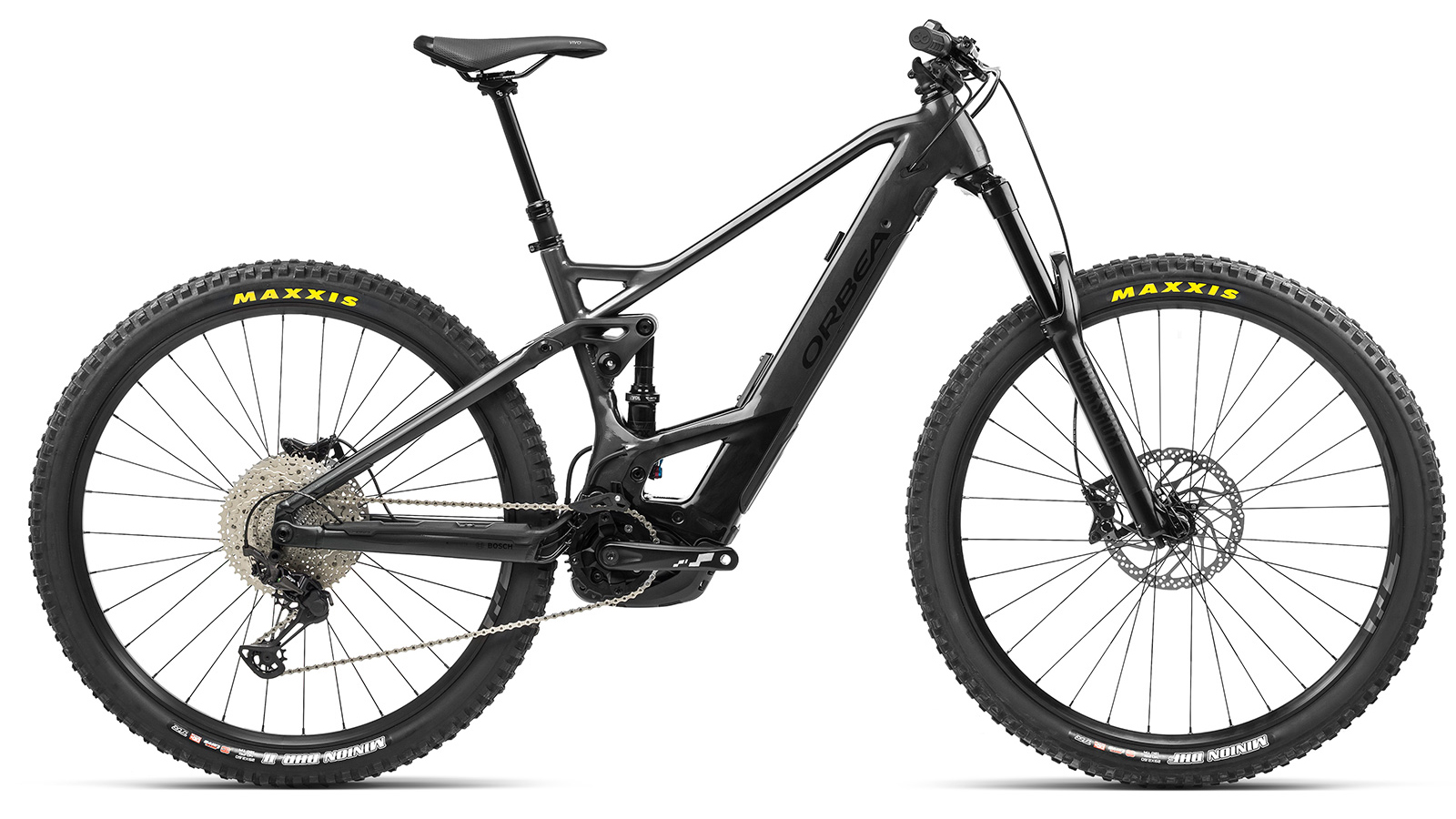
Orbea Wild FS H30
Specifications
Reasons to buy
Reasons to avoid
Orbea pitches its Wild FS series as a do-everything bike that's as fun on flow trails as it is capable on technical terrain. Orbea has gone for 29er wheels front and back for improved rolling ability although the low bottom bracket and 160mm cranks brings rider weight lower for a planted feeling in the corners. The steep seat angle will help keep the front wheel under control and the rear wheel gripping as gradient steepens, especially with Bosch's excellent Performance CX motor providing full assistance. A 750Wh battery is mounted in the downtube, although for big days out Orbea's 2Pac system allows an additional battery to be mounted inside the triangle for extra battery capacity.
The suspension is a joint responsibility between RockShox and Fox. There's a RockShox 35 Silver TK fork up front and a Fox Float DPS Performance Trunnion shock with a three-Position Evol LV custom tune-in the rear. The drivetrain is from Shimano and is a dependable mix of Shimano Deore and 12-speed XT. The finishing kit is all from Orbea including the wheels which have Maxxis Minion DHF/DHR II tires fitted with tough EXO+ casings.
Overall, the spec is decent for the money, but the cheaper Silver version of the RockShox 35 fork lets it down.
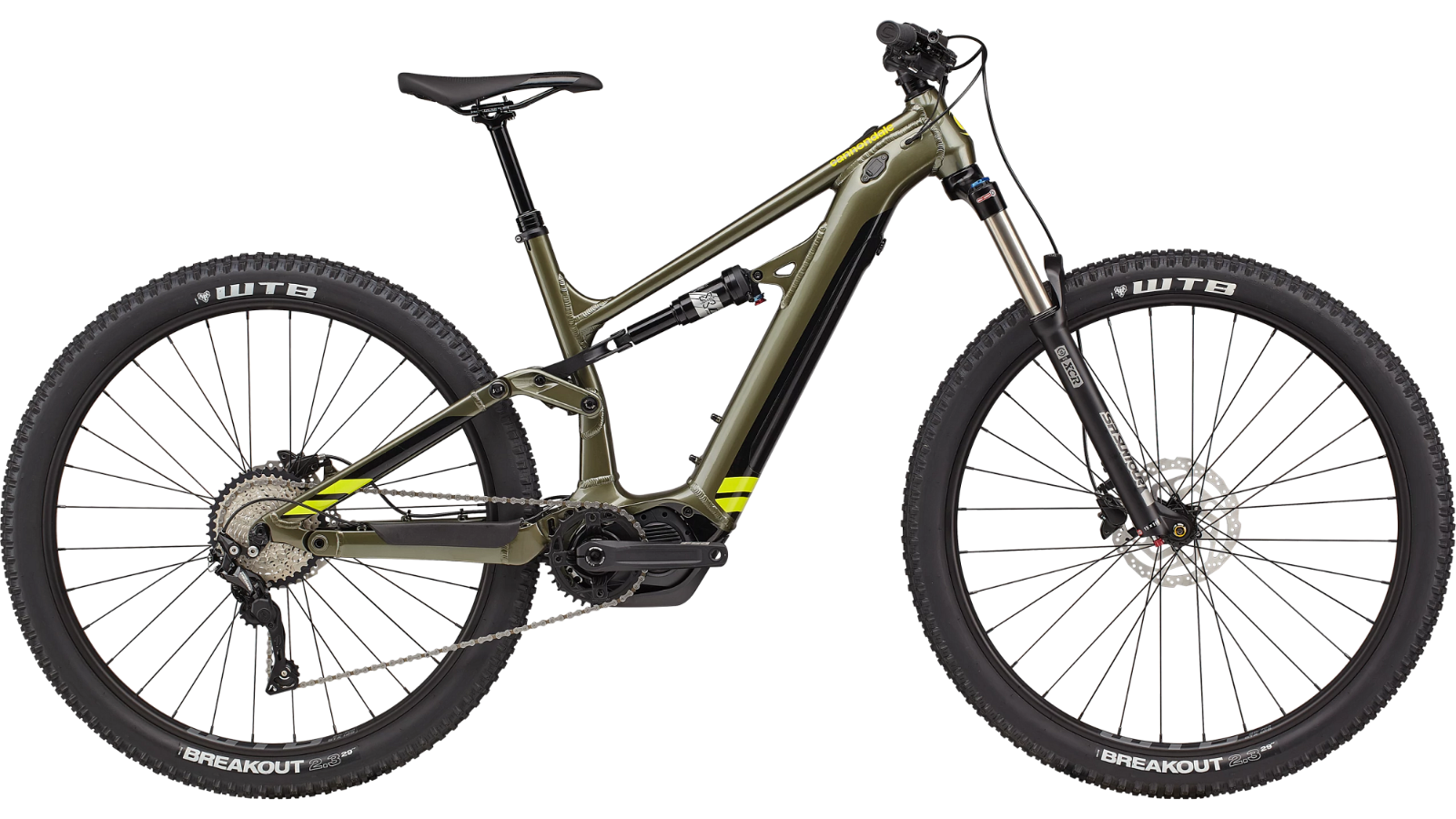
Cannondale Moterra Neo 5
Specifications
Reasons to buy
Reasons to avoid
Cannondale's Moterra Neo 5 is an aluminum e-MTB designed for all-mountain use and capable of going the distance. It makes use of the brand's SmartForm C3 Alloy construction and is a trail-rider at heart that thrives in the mountains. Featuring a Shimano STEPS E7000 drive unit with 504Wh battery, it has a range of up to 100km (60 miles), making it a great option for those wishing to roam and explore.
In terms of handling, the Moterra Neo 5 is precise and agile, with a low center of gravity combined with short chainstays, which put the rider in a central upright position. This is ideal if you plan to make use of that full 100km range, as it's a position that you can comfortably hold for a full day in the saddle.
How to choose the best budget e-MTB for you
With increasing numbers of electric mountain bikes appearing everywhere. choosing the best one for you has become more difficult. If you're finding it tough to choose between them all, here's some advice from our expert test team on things to things to consider when buying a budget e-MTB...
- Motor position – There are a lot of so-called 'electric mountain bikes' out there that aren't really up to the job of proper mountain biking. The vast majority of the cheaper models have their motor in the rear hub. While this can be fine for commuting or flat trail riding, having all the motor weight at the rear of the bike doesn't give the much more balanced handling of a motor mounted at the bottom bracket position. Motors situated at the BB are where all e-MTBs worth their salt have them, as having a well balanced bike is vital when riding proper trails. Rear hub motors tend to be lower power too. The bottom line is to avoid rear hub motors for MTB – all the bikes featured in this guide have BB-positioned motors.
- Hardtail or full-suspension? – Unlike regular mountain bikes where hardtails (front suspension only) work really well, the extra weight of an e-MTB causes problems when riding trails. While the front suspension fork soaks up lumps, bumps and impacts, a lack of suspension at the rear of an e-bike means it will struggle to maintain proper traction compared to a full-suspension e-MTB. However, if you plan to stick to easier trails, an electric hardtail can be a decent choice. For more challenging riding though, we'd definitely recommend a full-suspension e-MTB.
- Frame materials – Just like cheaper mountain bikes, e-MTBs with lower price points have frames made from aluminum alloy rather than carbon fiber. This makes them heavier than pricier carbon models, and while there are a couple of carbon-framed bikes in this guide, they're at the more costly end of the budget spectrum.
- Wheel setups – The most popular wheel sizes options in mountain biking these days are 29-inch front and rear, or mullet wheeled – aka a 29in front and a smaller 27.5in rear. This very much applies to electric mountain bikes too. Twin 29in wheeled bikes roll faster than mullet setups, though the mixed wheel option gives a more agile and fun ride. Also, keep an eye out for Boost-width wheels, forks and frames. This is the most modern standard and will give you more options if you decide to upgrade your wheels or front fork later.
Best budget e-MTBs: everything you need to know
Do I need a hardtail or full-suspension e-MTB?
If you want an e-bike for tackling technical trails with serious rocks, drops and other challenges, then you definitely want full-suspension. Otherwise, all that hefty battery and motor weight is going to be smashing into stuff with nothing to absorb the impact, which will affect your ride quality. That makes even the best hardtail mountain bikes quite a battering experience on proper MTB trails.
In contrast, that extra weight actually makes even basic rear suspension feel much better thanks to the greater contrast in sprung-to-unsprung weight ratio. Or to put it another way, all that bike mass (the sprung bit) is harder to move so the unsprung bit (the wheels, rear swingarm etc.) move more, making even basic dampers feel more supple and sensitive.
What brand of motor is best?
We always recommend sticking with big brand motors, such as Bosch, Shimano and Brose, to get the best level of support and to make it easier to find help if you have an issue. Each brand has a range of motors available so you might find that some budget e-MTBs use less powerful versions that are designed for town bikes. That doesn’t have to a deal-breaker. Just be prepared to pedal a little harder than riders on full-power bikes. For more info, take a look at our guide to the best e-MTB motors you can buy.
How much does an e-MTB weigh?
Regular electric mountain bikes with powerful motors and high capacity batteries are heavy and typically weigh around 25kg. But there are growing numbers of lightweight electric mountain bikes, sometimes known as 'half-fat' e-MTBs. These bikes are designed to be as light as possible and give lower levels of motor assistance so they feel more like a regular mountain bike. Models such as Orbea's Rise can be as light as 16kg and come with lighter electric components like 360Wh batteries to help keep the weight down.
What should I look for in a battery?
Batteries are really expensive, too, so some designs use fewer cells in their batteries to save cost. A smaller battery will also be lighter so you could actually see that as a bonus. How the battery is mounted doesn’t make a huge difference in performance, although it may affect the practicality of removing the battery for charging or mounting a water bottle. Some internal battery frames are stiffer than external mount frames but most aren’t. External battery designs are simpler and therefore cheaper to design and make, and they are almost always easier to remove for charging off the bike. They don’t look nearly as slick though, and external batteries are more prone to loosen and rattle.
How much suspension do I need?
If you’ve added about 10kg of motor and battery weight to your bike, then you may as well have enough travel to enjoy those extra descents it’s gifting you. We think there should be at least 130mm of rear travel and 140mm or more in the front. Make sure you still pay attention to quality, not just quantity, as a bike that blows through its travel or has really mushy pedaling will never feel as good as a properly controlled machine that you can push your limits on.
What about the handling?
You’ll generally be going a lot faster if you’ve got a motor helping you and the force due to gravity will be greater when descending. You’ll have to wrestle a lot more bike mass through corners and tech sections, too, so you need all the help you can get. That means a head angle of 66 degrees or less and a generous reach for stability at high speeds. You don’t want it to feel like a total barge, though, so you want a wide bar for leverage and a short stem for quick reactions.
Are there any other components I need to consider?
With more weight and speed to control, brakes are the obvious thing that needs to be more powerful and reliable than normal on an e-MTB. Look for 200mm+ rotors on either end to be sure of stopping. Tires, particularly at the back, take a pounding even with full suspension, so if you don’t get reinforced casing set up tubeless then definitely upgrade ASAP – our guide to the best e-MTB tires can point you in the right direction. Wheels are important too. Not just strong rims and build quality, but also rear hubs that can take all the extra torque being delivered by the motor. You might not get all of this when looking at budget bikes, but if it comes down to a choice between otherwise similar machines, make sure you check the details.

Guy Kesteven has been working on Bike Perfect since its launch in 2019. He started writing and testing for bike mags in 1996. Since then he’s written several million words about several thousand test bikes and a ridiculous amount of riding gear. He’s also penned a handful of bike-related books and he reviews MTBs over on YouTube.
Current rides: Cervelo ZFS-5, Specialized Chisel, custom Nicolai enduro tandem, Landescape/Swallow custom gravel tandem
Height: 180cm
Weight: 69kg
- Rich OwenEditor, BikePerfect
